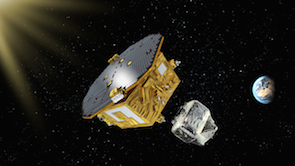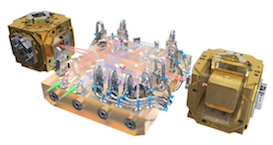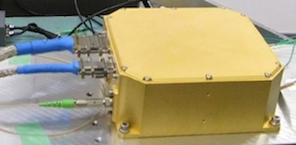Lights on for LISA Pathfinder
12 January 2016
While LISA Pathfinder is en route to its operational orbit, the science and engineering teams are testing the systems on the spacecraft. This week, they will begin to switch on elements of the science payload, including the laser that will be used to monitor the most precise free-fall motion ever obtained in space. |
| Artist's impression of LISA Pathfinder after separation of the propulsion module. Credit: ESA/C. Carreau |
Launched on 3 December 2015, LISA Pathfinder has used its propulsion module to raise its orbit six times and embark on the path to its operational orbit around the Lagrange point L1, 1.5 million km from Earth in the direction of the Sun. After releasing the propulsion module on 22 January, the science module will enter its final orbit. Science operations will then begin on 1 March.
At the centre of the science module lies the LISA Technology Package, the scientific heart of the mission, housing the two test masses. Once the spacecraft is in a stable orbit around L1, this pair of identical gold-platinum cubes will be set free to move under the influence of gravity. A laser interferometer will track their motions and measure the minuscule changes caused by forces other than gravity, to assess how much they deviate from actual free fall.
Even in space, isolating a test mass from all the non-gravitational forces acting on it is a daunting endeavour. Demonstrating that such an accurate free-fall can be obtained is a crucial condition for future space-borne observatories of gravitational waves. These waves are the tiny fluctuations in the fabric of space-time predicted by Albert Einstein's General Theory of Relativity.
During LISA Pathfinder's cruise to L1, teams from ESA and Airbus Defence and Space (the prime contractor) have been commissioning the spacecraft, verifying that all systems, subsystems and instruments function as expected. Just before Christmas, the cold gas micro-newton thrusters, which will be used to accurately adjust the spacecraft position by tiny shifts during the operations phase, were first activated. Last week, the colloidal micro-newton thrusters, provided by NASA-JPL as part of the Disturbance Reduction System, were switched on and tested.
This week, the teams start commissioning the LISA Technology Package, switching on the payload computer and other electronics, testing the control unit of the caging mechanism that holds the test masses secure during launch and cruise, and verifying that the radiation monitor works well.
On 13 January, they will switch on the laser, the first scientific component of the LISA Technology Package to be activated. During science operations, the laser will be used to feed two light beams to the interferometer, which will measure the position and attitude of the free-falling test masses to unprecedented accuracy.
 |
 |
| Left: Illustration of the two test masses and the laser interferometer. Credit: ESA/ATG medialab. Right: LISA Technology Package reference laser unit. Credit: Tesat, Germany | |
"We are very happy with how the spacecraft commissioning has gone so far, and by switching on the first subsystem of the payload we are now one step closer to science operations," says Paul McNamara, ESA's LISA Pathfinder project scientist.
Over the next couple of days, the teams will perform a number of tests to examine how the laser, which was calibrated on the ground, works in space. In particular, they will verify the laser performance under many different combinations of temperature and power output from the pump diode module that provides energy to the laser crystal, collecting data that will be crucial to run the laser during science operations.
| Simulation of commissioning of the LISA Technology Package carried out in September 2015. (Click here for further details and larger versions of this video.) |
On 22 January, the propulsion module will be separated from the science module in order to reduce the self-induced gravitational disturbances, and the science module will proceed on its journey to L1.
The commissioning of the spacecraft and instruments will continue until the end of February. During this period, the test masses will be released, in a two-step process, from the mechanisms that have been holding them secure in position during the launch and cruise phase.
First, on 3 February, the launch lock fingers on the eight corners of each cube will be retracted, and simultaneously a gate valve will open to vent the interior of the test mass housing to space. After that, however, the masses will still be held in place through the Grabbing, Positioning and Release Mechanism (GPRM), attached to two opposite faces of each cube.
Then, the GPRMs will be retracted on 15 and 16 February – one cube per day – and the test masses will no longer be in mechanical contact with the spacecraft. Even then, the masses will not be in drag-free motion yet, but they will follow the spacecraft via electrostatic actuation until the science mode is activated, at the end of February, and the spacecraft will finally start moving around one of the free-falling cubes.
For further information, please contact:
Paul McNamara
LISA Pathfinder Project Scientist
Scientific Support Office
Directorate of Science
European Space Agency
Email: paul.mcnamara![]() esa.int
esa.int
Phone: +31 71 565 8239




